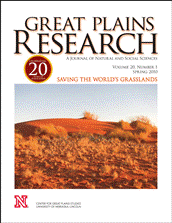Center for Great Plains Studies

Great Plains Research: A Journal of Natural and Social Sciences (through 2013)
Date of this Version
2007
Document Type
Article
Abstract
Knowledge of how current-year grazing and drought stress affect subsequent-year herbage production is needed to enhance the management of semiarid Sandhills prairies. This study quantifies subsequent- year effects of defoliation and precipitation on prairie sandreed (Calamovilfa longijolia), a high-seral, warm-season tallgrass, and total graminoid herbage production in the Nebraska Sandhills. Mainplots (9.0 m2) received either ambient precipitation (noncovered) or precipitation was excluded during April-May, June-July, or August-September, resulting in 66% to 135% of the long-term average (434 mm) precipitation. All species in 1.0 m2 defoliated subplots were clipped in early July at the stubble height required for 30%, 60%, or 90% defoliation of C. longifolia. Measurements were made during July of the following year. Yield of C. longifolia declined about 5% for each 10 percentage points of defoliation compared to 3% yield declines for all graminoids (grasses and sedges) combined, regardless of precipitation regime. Additionally, excluding precipitation during June-July reduced tiller density by about 44% and yield and percent composition of C. longifolia by about 25% compared to ambient precipitation. Periodic full growing-season deferment may be necessary to maintain high-seral species dominance in these grassland communities, particularly in pastures where overgrazing and drought stress occur concurrently during June or July.


Comments
Published in Great Plains Research17:215-24 (Fall 2007). Copyright ©2007 Center for Great Plains Studies, University of Nebraska-Lincoln.